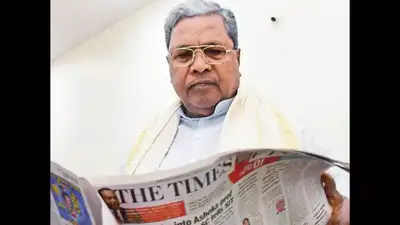ARTICLE AD BOX

On the occasion of the 41st anniversary of The Times of India, Bengaluru, the chief minister of Karnataka, Siddaramiah, took time out to speak on a range of issues including the primacy of the print media and its role in the forefront of responsible journalsim. He also spoke on his vision for Bengaluru.Excerpts from the interview:
What was your very first impression of Bengaluru when you entered politics in 1983-84?When I first started visiting Bengaluru frequently during the early years of my political journey, it felt like a serene, green, and intellectually vibrant city. It was a city of public sector institutions, scientific minds, students, and quiet dignity.
There was a sense of purpose and progressive thinking in its air, whether in the legislative corridors, university campuses, or bustling marketplaces. Bengaluru was also a crucible of ideas. Even then, it was an ever-growing city, aspirational, dynamic, and deeply rooted in democratic values.What do you believe Bengaluru stood for in the past four decades and what it represents now?Bengaluru has always been more than just a city: it has been the heartbeat of progressive politics, democratic assertion, and transformative change in India.
From being a quiet pensioners’ paradise, it has evolved into the startup capital and technology nerve centre of the country. But even as skyscrapers replaced bungalows, Bengaluru has never lost its soul and is rooted in secularism, scientific temper, and social justice.Over the decades, Bengaluru stood for the aspirations of ordinary people, for those seeking dignity in labour, fairness in opportunity, and freedom in expression.
It became a refuge for thinkers, workers, entrepreneurs, and reformers. It welcomed all with open arms and gave them space to dream. Every major progressive shift in India’s social or technological landscape, be it in public sector innovation, IT revolution, civic activism, or people’s movements, has found its early pulse in Namma Bengaluru.Bengaluru’s strength lies in its people, their ideas, their activism, and their unyielding belief in democracy.
And it is this spirit that our government is committed to preserving.What is your government’s response to the present challenges of traffic, infrastructure and aspirations of Bengalureans?When I took oath as CM, I dreamt of a Bengaluru that would wipe out urban poverty, welcome every innovator and entrepreneur, and build world-class infrastructure that upholds dignity for all. We upgraded roads, introduced white-topping and TenderSURE, and eased traffic with planned efforts. Sadly, years of BJP’s misrule pushed our city into neglect and chaos.
I assure every Bengalurean today: we will rebuild the glory of Bengaluru.
In our 2025 Budget, we have committed over 10,000 crore to projects that will address Bengaluru’s traffic and infrastructure issues. As part of this, a 40.5km double-decker flyover will be constructed alongside Namma Metro Phase-3, at a cost of 8,916 crore, providing multi-modal integration for faster commute.We are fast-tracking all metro phases, pushing ahead with the Suburban Rail system, and taking up the Peripheral Ring Road Project, a crucial decongestion route left stalled for years by the BJP. A 300km road network along canal buffer zones is being developed with 3,000 crore. BBMP’s arterial and sub-arterial roads spanning 460 km will be scientifically upgraded at a cost of 660 crore. We are also constructing 120km of flyovers and grade separators to improve citywide connectivity, while evaluating tunnel roads for long-term congestion relief.Through citizen engagement, environmental consciousness, and scientific planning, we are restoring people’s faith in the city’s future.
Bengaluru is not merely an economic engine, it is an idea that reflects the aspirations of modern India.Do you believe Bengaluru needs to become autonomous like most other global cities like London, New York?I believe that the governance of a city must be rooted in decentralisation and responsive administration. Decentralisation is a cornerstone of our governance model. However, we must understand Bengaluru not just as an isolated urban centre but as the capital that reflects and influences the socio-economic dynamics of the entire state.Bengaluru belongs to all Kannadigas, it is a home for people from every district, every village, and every aspiration.Any attempt to create a hyperautonomous city model, detached from the rest of Karnataka, would be politically shortsighted and economically unbalanced. Our approach is one of balanced urbanisation, where we empower local governance, ensure administrative flexibility, and integrate the city’s development with the state’s broader goals of equity, inclusion, and shared prosperity.
Bengaluru’s future must be shaped by both its global ambitions and its regional responsibilities.This balance is what defines the political economy of a progressive democracy.What is your vision for Bengaluru?My vision for Bengaluru is of a city that is equitable, sustainable, and globally admired and not just for its tech prowess, but for its quality of life. I see Bengaluru as a city where lakes are rejuvenated, public transport is efficient, housing is affordable, and civic sense thrives.
A city that is as kind to its poorest as it is enabling for its entrepreneurs. A city where governance is transparent and participatory.Your message to the citizens...Your dynamism is this city’s greatest strength. We should work together to preserve Bengaluru’s soul. Participate in civic life, hold your government accountable, and continue contributing to the city’s inclusive growth. Your voice matters in shaping the Bengaluru of tomorrow.Your views on print media and its relevance today.Even in this digital age, print media continues to be a vital pillar of our democracy. Newspapers like The Times of India have built trust over generations. In today’s world of misinformation, print remains a source of responsible journalism and nuanced reporting. Its role in shaping public discourse, educating readers, and holding power accountable is more relevant than ever.



.png)
.png)
.png)
















 5 hours ago
3
5 hours ago
3









 English (US) ·
English (US) ·